New Switchback Ramp Between Civic Center MetroLink & Gateway Transportation Center Should Reduce Accidents
To reduce pedestrians being hit by light rail trains they’ve been making changes to conflict points, this is about the access to the Civic Center MetroLink Station from the Gateway Transportation Center, which opened in late 2008.
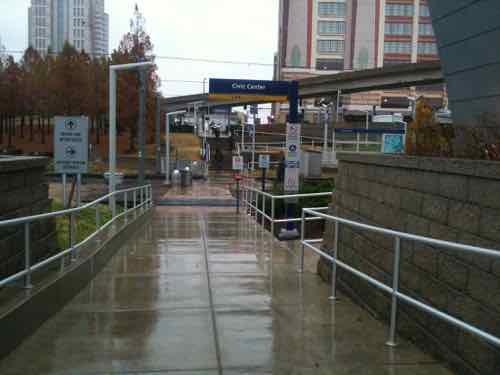
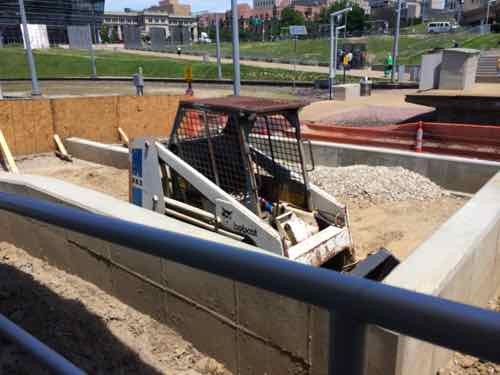
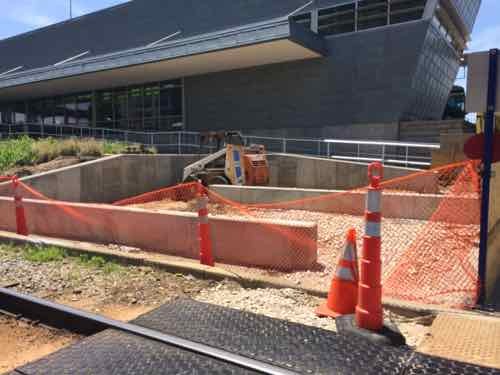
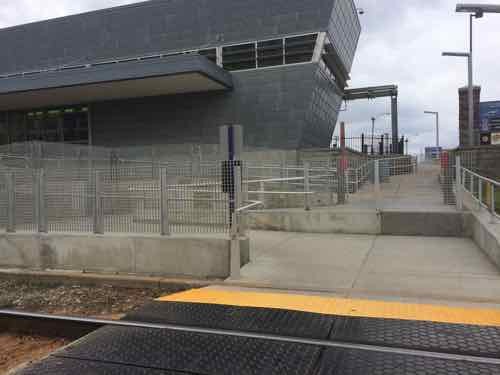
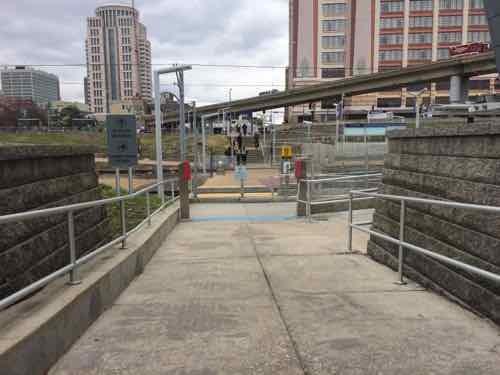
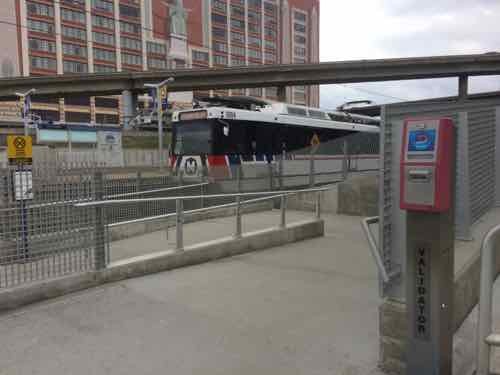
This change may also be related to the coming smart card technology, a reader is shown above. The question I have is will I have a problem passing through the Civic Center MetroLink to reach the Gateway Transportation Center?
— Steve Patterson
Looks over engineered?
Desire lines are seriously important in urban planning right? There must be more subtle ways to avoid collisions here.
All of this is the result of poor planning of the site and execution of the Gateway Transit Center. Look at Victoria Station in London. It feeds a broad city surrounded by walking and transit with many small scale shops. Or look at the Helsinki Central Station, designed by Elliel Saarinen the father of the Architect of the St Louis Arch, Eero. The station vigorously feeds central Helsinki and the rest of Finland, and again as with Victoria Station. is surrounded by a small scale commercial with a walking, transit friendly environment as part of a design solution.
In both cases the urban design is far superior to the St. Louis Gateway Station. Even a look back at the old Union Station terminal on Market Street will reveal a presence in the landscape similar to London and Helsinki.
Instead today there is a poorly conceived, located and executed central station in St. Louis that has to find convoluted solutions to cover for its outmoded and poor design. At a minimum the whole thing is a joke to start with. The switchback discussion is the natural outcome of a city that has lost its way.
No, this is a conscious effort to make pedestrians look for oncoming trains before they get hit! It has nothing to do with great urban design or grand european train stations, it has everything to do with preventing people from being stupid, on a micro level!
No, it is the same attempt to cover up for piss poor urban planning. Piss poor urban planning is pretty well the status quo for St. Louis. Ha Ha do you want examples of the total incompetence of St. Louis leadership?
The whole point is that this is a broad problem that impacts the micro level and in fact causes, as in this case, money to be spent to correct the incredible incompetence of St Louis officials.
It has nothing to do with Europe, in fact I would point you to St. Louis Union Station as a successful urban form except the brilliant planners in St. Louis have destroyed the urban environment that once supported this central station in St. Louis. So there is nothing to look at except a monumental stone building that might as well be sitting in a pasture near Owensville Missouri as well in St Louis.
I have mixed feelings about the “urbanity” of both the Civic Center MetroLink Station and the Gateway Transportation Center, as well, but that’s not the subject of this post. This is a post about a straight-forward modification to improve rider safety, similar to what Metro has done at many other stations. Most of us were taught to “look both ways before crossing a street” (and this is similar to crossing a street), but many riders, today, are so engrossed with their digital media (earbuds and smartphones) that transit properties need to take more extreme measures just to get people to pay attention: http://well.blogs.nytimes.com/2013/06/28/dangers-of-distracted-walking/?_r=0 . http://enddd.org/safety-on-the-road/distracted-walking-an-issue-for-all-particularly-teens/
As for “piss poor urban planning”, I give the designers of the Gateway Transportation Center a lot of credit for successfully “connecting the dots” in the 21st Century. Amtrak wants a “pull-thru” station, not one that you need to back into (the Union Station train shed), the Amtrak mainline is next to an elevated freeway, Greyhound wants easy access to the freeway, and Metrolink, downtown, was cobbled together using an abandoned freight rail line. And, the facility is sized to handle the number of bus and rail passengers using those modes TODAY, not the much, much higher numbers that used those modes 75-100 years ago.
We can argue all we want about whether or not better design will yield better or different results, but the reality is that the world is a constantly changing place. We have less that a dozen passenger trains every day, not 100 or more. In the first half of the 20th Century, Union Station was the right answer; today, it’s far too big for the number of riders who would be using it for train travel. The current facility is much closer to the “right” size, but suffers from being crammed in and around existing infrastructure.
Rarely, and especially in existing urban areas, do designers start with a truly “clean sheet of paper”. Denver International Airport was a “clean sheet” design that opened 20 years ago, yet there are already significant changes happening, there. Lambert, like O’Hare, Laguardia, LAX and Kennedy, is over a century old, with infrastructure from every decade in between. Downtown St. Louis (and EVERY other city) is in the same boat – decisions made 10, 20, 50, 100 and 150 years ago shape the city, for better and for worse, and will continue to do so.
It’s not “the brilliant planners in St. Louis [who] have destroyed the urban environment that once supported this central station in St. Louis”, it’s the multiple, incremental choices, by many thousands of people, that personal vehicles and air travel are far superior to mass transit and passenger rail service, that have doomed the grand train stations and steered public funding to freeways and airports and private investment to suburban sprawl. Much like Venture, Woolworth’s, Stix-Baer, Lemp and Flagstaff, if you’re selling something that most people no longer find to be relevent, you’re going to shrink into obscurity, while the new upstarts, like Amazon, Apple, Walmart, Urban Chestnut and New Belgium, who do a “better” job of getting people what they “want”, capture their hard-earned dollars . . . .